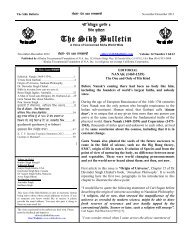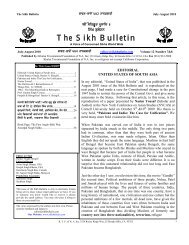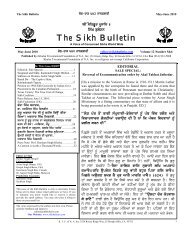You also want an ePaper? Increase the reach of your titles
YUMPU automatically turns print PDFs into web optimized ePapers that Google loves.
<strong>The</strong> <strong>Sikh</strong> <strong>Bulletin</strong> hwV-swvx 537 June-July 2005<br />
growing quite fast in the west and Russia. Please help us as<br />
we are stuck. To give you an example of what they are all<br />
about we found the following websites:<br />
http://www.sikhnet.com (This is a pretty good site and<br />
helpful) http://www.hope.at/sikhism (This site is very easy<br />
to follow, check it out, they have a Woman’s section and a<br />
Martyrs’ section. It looks like that you are not the only one<br />
trying to expose the falseness of Islam. <strong>Sikh</strong>s scholar did it<br />
hundreds of years ago and got killed for it!<br />
http://www.sikhs.org (This is the site that was on CNN when<br />
<strong>Sikh</strong>s in the USA were mistaken for Arabs and Middle<br />
Easterners and were attacked by mindless morons)<br />
Please help us out; we can’t make our website about religion<br />
being the cause of war and disharmony when we have this<br />
one and only religion which makes a hell of a lot of sense! (I<br />
thought Atheism had all the answers but were kind of stuck<br />
now.) We look forward to hearing from you, we respect your<br />
great views and want to promote them to everyone, thank you<br />
for your time, take care.<br />
*****<br />
WHAT MAKES YOU A SIKH<br />
Let me try and approach this question in a slightly different<br />
manner than is usually done. <strong>The</strong>re are of course definitions<br />
of a <strong>Sikh</strong> in the Reht Maryada, in the 1925 Gurdwara<br />
legislation and in the legislation setting up the Delhi <strong>Sikh</strong><br />
Gurdwara Management Committee. But what they all have in<br />
common is that they do not talk about the relation between a<br />
<strong>Sikh</strong> and Vahiguru, Parmatma, or by whatever other name<br />
you know God.<br />
We know that <strong>Sikh</strong> means pupil, or one under training. Not<br />
so many know that Khalsa is derived from a Farsi word for<br />
lands directly under the rule of the emperor. This means in<br />
our case that a Khalsa is a person who puts herself / himself<br />
directly under the command of God.<br />
But what does Guru Granth Sahib have to say Guru Granth<br />
Sahib does use words like <strong>Sikh</strong> and khalsa, but does not use<br />
these as describing people of a particular sect or religion.<br />
Guru Granth Sahib does not teach a religion in the western<br />
meaning of that word, it teaches a dharm, a way of life.<br />
So what is expected from those that follow this dharm A<br />
follower of the <strong>Sikh</strong> dharm recognises only the One as the<br />
Mother and Father of all, and has to work on getting as close<br />
to the One as is possible for a human being. This is done by<br />
remembering the One at all times, by seeing the presence of<br />
the One, the All Pervading, the All Powerful, in all and<br />
everything. This attitude goes hand in hand with honesty,<br />
with compassion, with respect, with defending the<br />
defenceless and fighting against injustice.<br />
Most of us will know the often quoted three <strong>Sikh</strong> qualities:<br />
honest work, sharing with others and remembrance of<br />
Vahiguru. <strong>The</strong>y point to the two sides of ‘simran’ or<br />
remembering: play a positive role in society, and have a real<br />
relationship with God.<br />
When I grew up I went to a Christian school, and on Sunday<br />
went with my friends to the Sunday school. I was quite a<br />
pious little boy, but later lost my faith in spite of meeting<br />
some really good, Godly Christians, whom I still admire.<br />
<strong>The</strong> truth is that none of them managed to point me on the<br />
way to God, on the way where God is not just a theoretical<br />
concept, but where She / He can be experienced. Now I do<br />
not have to ‘believe’ in God, I have met with God, I know<br />
that She / He is. This I think is the essential part of being a<br />
<strong>Sikh</strong> or a Khalsa (with or without capital letters). Meeting<br />
God, having darshan, living with God 24 hours a day, that is<br />
what being a <strong>Sikh</strong> or a Khalsa is all about. Why is it that so<br />
many people who look like <strong>Sikh</strong>s do not really understand<br />
this concept<br />
<strong>The</strong> man in blue.<br />
harjindersinghkhalsa@yahoo.co.uk<br />
*****<br />
ANAND MARRIAGE ACT, 1909 --- WAY<br />
BEHIND TIMES<br />
A PROPOSAL FOR AMENDMENT<br />
-Hirdey Pal Singh*<br />
<strong>The</strong> marriage ceremony performed according to the <strong>Sikh</strong><br />
rites is called Anad Karaj. <strong>The</strong> word Anand literally means<br />
‘pleasure’ or ‘rejoicing’ and is synonymous with the Persian<br />
word Shaadi (marriage) 1 . This marriage ceremony has been<br />
in vogue among the <strong>Sikh</strong>s since the time of Guru Amar Das<br />
(1552). <strong>The</strong> Laavan or the four marriage hymns were<br />
composed by Guru Ram Das 2 . <strong>The</strong> practice went out of<br />
currency during the times of the Maharaja Ranjit Singh and<br />
was revived as a part of the religious reforms carried out by<br />
the Nirankari movement and furthered by the Singh Sabha 3 .<br />
<strong>The</strong> Anand Marriage Act was passed by the Imperial<br />
Legislative Council in 1909 in spite of great opposition. <strong>The</strong><br />
Anand Marriage Bill was originally introduced in the<br />
Council by Tikka Ripudaman Singh of Nabha in 1908. <strong>The</strong><br />
Bill had been drafted by a committee of the Chief Khalsa<br />
Diwan. Mass meetings were held all over Punjab and<br />
various <strong>Sikh</strong> Organisations sent telegrams and petitions by<br />
thousands demanding the passage of the Bill. In 1909,<br />
Sunder Singh Majithia replaced Tikka Ripudaman Singh as<br />
the member of the Imperial Council and moved the Bill on<br />
Friday, 10 September, 1909. <strong>The</strong> Anand Marriage Act was<br />
enacted on 22 October, 1909 4 .<br />
<strong>The</strong> preamble to the Anand Marriage Act, 1909 gives its<br />
purpose as, “This form of marriage has long been practised<br />
among the <strong>Sikh</strong>s but there are good reasons to believe that<br />
in the absence of validating enactment, doubts may be<br />
thrown upon it and <strong>Sikh</strong>s may have to face great difficulties<br />
in future and incur heavy expenses on suits instituted in the<br />
Civil Courts”. <strong>The</strong> concern presented in the statement of the<br />
K.T.F. of N.A. Inc. 3524 Rocky Ridge Way, El Dorado Hills, CA. 95762 9
















